词义的选择
- 格式:ppt
- 大小:3.65 MB
- 文档页数:20
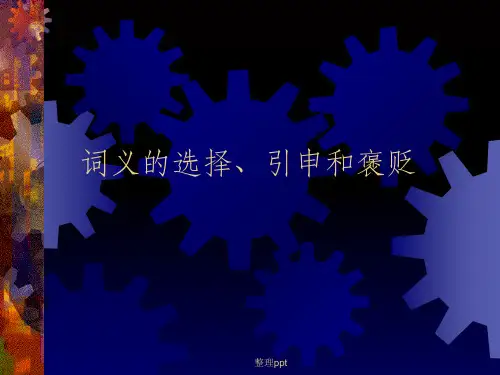
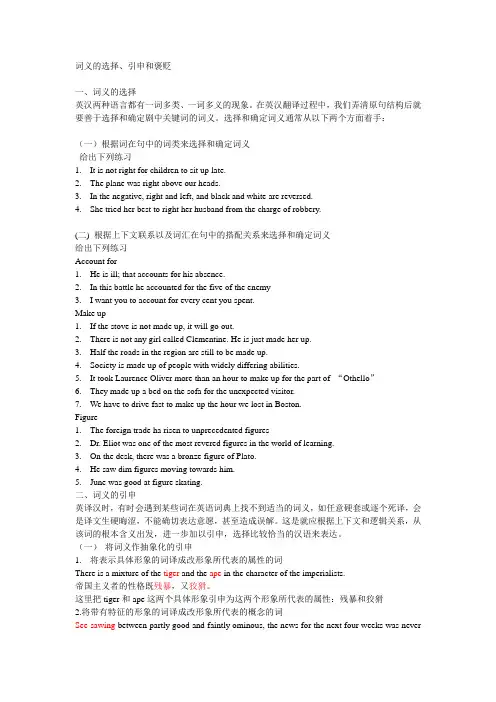
词义的选择、引申和褒贬一、词义的选择英汉两种语言都有一词多类、一词多义的现象。
在英汉翻译过程中,我们弄清原句结构后就要善于选择和确定剧中关键词的词义。
选择和确定词义通常从以下两个方面着手:(一)根据词在句中的词类来选择和确定词义给出下列练习1.It is not right for children to sit up late.2.The plane was right above our heads.3.In the negative, right and left, and black and white are reversed.4.She tried her best to right her husband from the charge of robbery.(二) 根据上下文联系以及词汇在句中的搭配关系来选择和确定词义给出下列练习Account for1.He is ill; that accounts for his absence.2.In this battle he accounted for the five of the enemy3.I want you to account for every cent you spent.Make up1.If the stove is not made up, it will go out.2.There is not any girl called Clementine. He is just made her up.3.Half the roads in the region are still to be made up.4.Society is made up of people with widely differing abilities.5.It took Laurence Oliver more than an hour to make up for the part of “Othello”6.They made up a bed on the sofa for the unexpected visitor.7.We have to drive fast to make up the hour we lost in Boston.Figure1.The foreign trade ha risen to unprecedented figures2.Dr. Eliot was one of the most revered figures in the world of learning.3.On the desk, there was a bronze figure of Plato.4.He saw dim figures moving towards him.5.June was good at figure skating.二、词义的引申英译汉时,有时会遇到某些词在英语词典上找不到适当的词义,如任意硬套或逐个死译,会是译文生硬晦涩,不能确切表达意愿,甚至造成误解。
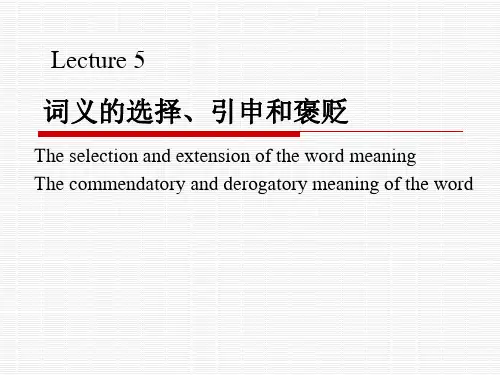
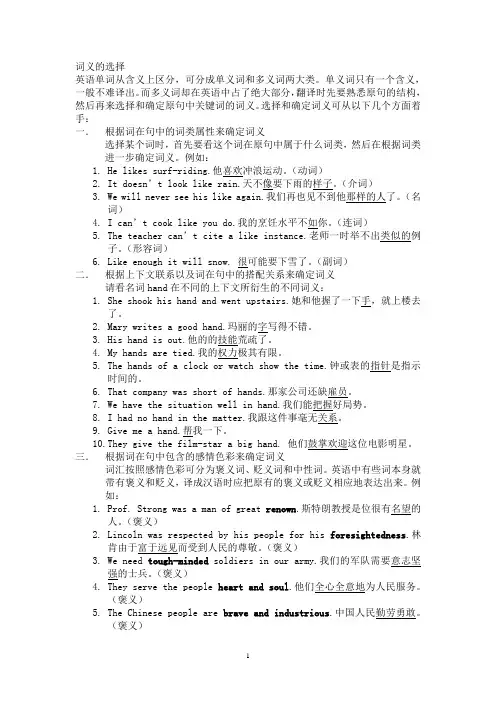
词义的选择英语单词从含义上区分,可分成单义词和多义词两大类。
单义词只有一个含义,一般不难译出。
而多义词却在英语中占了绝大部分,翻译时先要熟悉原句的结构,然后再来选择和确定原句中关键词的词义。
选择和确定词义可从以下几个方面着手:一.根据词在句中的词类属性来确定词义选择某个词时,首先要看这个词在原句中属于什么词类,然后在根据词类进一步确定词义。
例如:1.He likes surf-riding.他喜欢冲浪运动。
(动词)2.It doesn’t look like rain.天不像要下雨的样子。
(介词)3.We will never see his like again.我们再也见不到他那样的人了。
(名词)4.I can’t cook like you do.我的烹饪水平不如你。
(连词)5.The teacher can’t cite a like instance.老师一时举不出类似的例子。
(形容词)6.Like enough it will snow. 很可能要下雪了。
(副词)二.根据上下文联系以及词在句中的搭配关系来确定词义请看名词hand在不同的上下文所衍生的不同词义:1.She shook his hand and went upstairs.她和他握了一下手,就上楼去了。
2.Mary writes a good hand.玛丽的字写得不错。
3.His hand is out.他的的技能荒疏了。
4.My hands are tied.我的权力极其有限。
5.The hands of a clock or watch show the time.钟或表的指针是指示时间的。
6.That company was short of hands.那家公司还缺雇员。
7.We have the situation well in hand.我们能把握好局势。
8.I had no hand in the matter.我跟这件事毫无关系。


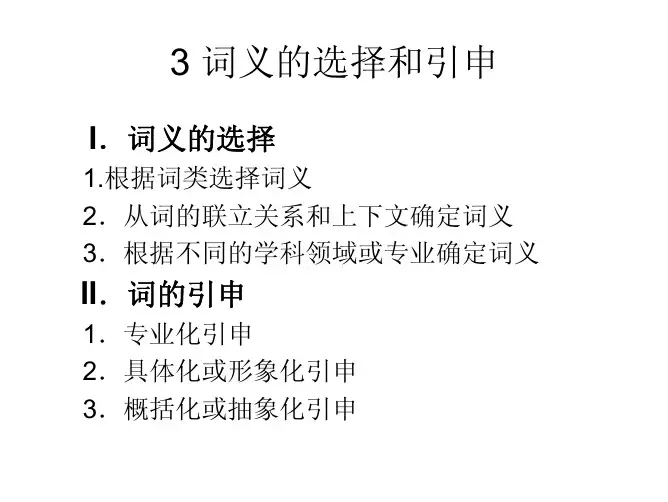
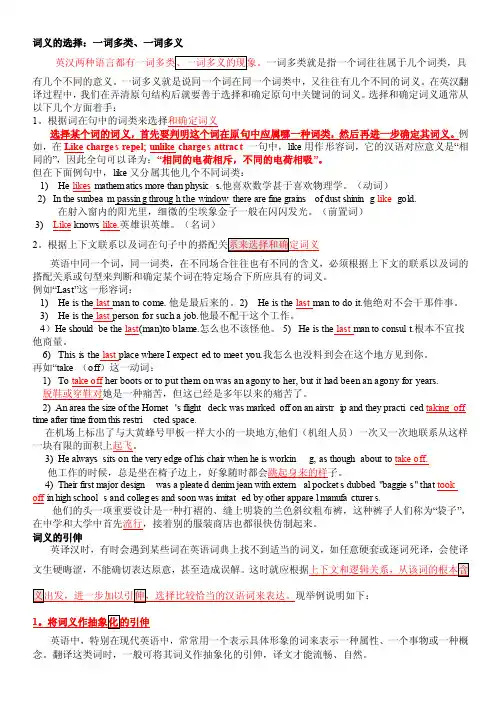
词义的选择:一词多类、一词多义英汉两种语言都有一词多类、一词多义的现象。
一词多类就是指一个词往往属于几个词类,具有几个不同的意义。
一词多义就是说同一个词在同一个词类中,又往往有几个不同的词义。
在英汉翻译过程中,我们在弄清原句结构后就要善于选择和确定原句中关键词的词义。
选择和确定词义通常从以下几个方面着手:1。
根据词在句中的词类来选择和确定词义选择某个词的词义,首先要判明这个词在原句中应属哪一种词类,然后再进一步确定其词义。
例如,在Like charges repel; unlikecharges attract一句中,like用作形容词,它的汉语对应意义是“相同的”,因此全句可以译为:“相同的电荷相斥,不同的电荷相吸”。
但在下面例句中,like又分属其他几个不同词类:1) He likes mathema tics more than physics.他喜欢数学甚于喜欢物理学。
(动词)2) In the sunbeam passing through the windowthere are fine grainsof dust shining like gold.在射入窗内的阳光里,细微的尘埃象金子一般在闪闪发光。
(前置词)3) Like knows like.英雄识英雄。
(名词)2。
根据上下文联系以及词在句子中的搭配关系来选择和确定词义英语中同一个词,同一词类,在不同场合往往也有不同的含义,必须根据上下文的联系以及词的搭配关系或句型来判断和确定某个词在特定场合下所应具有的词义。
例如“Last”这一形容词:1) He is the last man to come. 他是最后来的。
2) He is the last man to do it.他绝对不会干那件事。
3) He is the last personfor such a job.他最不配干这个工作。
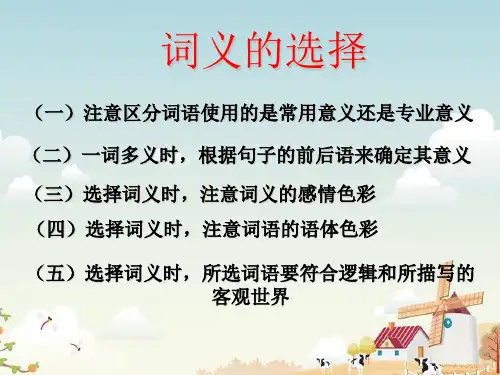
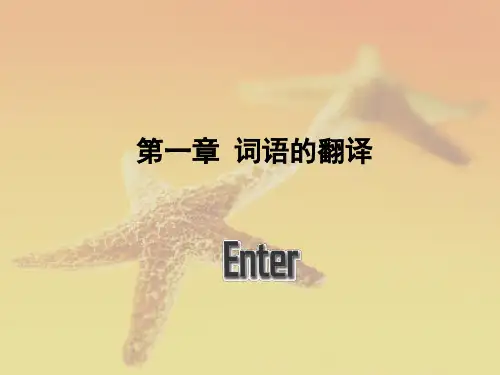
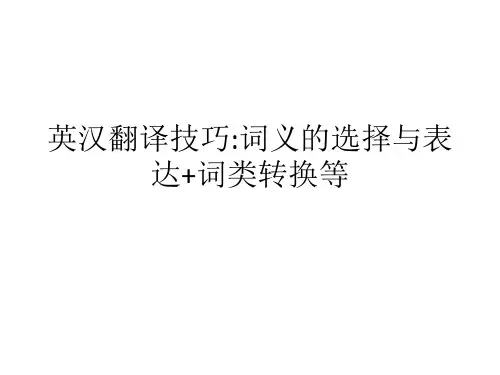
词义的选择、引申及褒贬一、词义的选择英汉两种语言都有一词多类、一词多义的现象。
一词多类就是指一个词往往属于几个词类,具有几个不同的意义。
一词多义就是说同一个词在同一个词类中,又往往有几个不同的词义。
在英汉翻译过程中,我们在弄清原句结构后就要善于选择和确定原句中关键词的词义。
选择和确定词义通常从以下两个方面着手:(一)根据词在句中的词类来选择和确定词义选择某个词的词义,首先要判明这个词在原句中应属哪一种词类,然后再进一步确定其词义。
例如,在like charges repel; unlike charges attract一句中,like用作形容词,它的汉语对应意义是“相同的”,因此全句可以译为:“相同的电荷相斥,不同的电荷相吸”。
但在下面各句中,like又分属其他几个不同词类:1)He likes mathematics more than physics.他喜欢数学甚于喜欢物理学。
(动词)2)In the sunbeam passing through the window there are fine grains of dust shining like gold.在射入窗内的阳光里,细微的尘埃像金子一般在闪闪发亮。
(前置词)3)Like knows like.英雄识英雄。
(名词)(二)根据上下文确定词义除了根据词性来判断词义之外,词义选择一个更为重要的方法就是根据上文来判断词义了。
因为很多英语单词即使弄清楚了词性,但仍须从几个或几十个义项中选定确切的词义。
这就需要借助于上下文提供的各种线索做出合理的分析、推理、判断。
有时候,我们还可能会在考试中碰到生词。
可是,我们绝对不会在一个英语句子中出现这种情况:某一个单词不认识,而这个单词上下文中的所有单词都不认识。
正因为上下文的存在,这也给我们翻译中解决生词提供了突破口。
因此,在翻译中,我们一定要随时注意上下文,上下文的不同在很大程度上决定了单词意义的不同,也在很大程度上决定了翻译中理解和表达的正确性、准确性和译文是否通顺。
词义的选择和引申(Diction and Extending Meaning)学习目标:了解词义的选择和引申的翻译方法能力目标:能运用词义的选择和引申翻译句子一、词义的选择英汉两种语言都有一词多类和一词多义的现象。
一词多类就是指一个词往往属于几个词类,具有几个不同的意义;一词多义就是同一个词在同一词类中,又往往有几个不同的词义。
因此译者把原文转换成译文时,不可避免地要遇到确定词义的问题。
译者在弄清原句结构后就要选择和确定原句中关键词的词义,以使所译语句自然流畅,完全符合汉语的表达习惯。
词义的选择和确定通常有以下三个方面:Task 1: 根据词在句中的词类来选择和确定词义要选择正确合适的词义,首先应确定这个词在该句子中属于哪一种词类,起什么作用,然后再进一步确定其词义。
例如:1. They are as like as two peas . 他们相似极了。
(形容词)2. Things like air, water or metals are matter.像空气、水或金属之类的东西都是物质。
(介词)3. He likes mathematics more than physics .他喜欢数学甚于喜欢物理。
(动词)4. It is the atoms that make up iron, water, oxygen and the like.正是原子构成了铁、水和氧等等。
(名词)Task 2: 根据上下文联系以及词在句中的搭配关系来选择和确定词义英语中同一个词,同一词类,在不同的场合中,词义往往不同。
因此,翻译时,必须根据上下文的联系以及词的搭配关系来判断和确定某个词在特定场合下应具有的词义。
例如:1. He is the last man to come. 他是最后来的”2. He is the last man to do it. 他决不会干那件事3. He is the last person for such a job. 他最不配干这个工作4. He should be the last to blame. 怎么也不该怪他5. He is the last man to consult. 根本不宜找他商量关于last的词义我们最熟悉的是“最后、末尾”,可由于上下文不同,翻译就完全不一样。